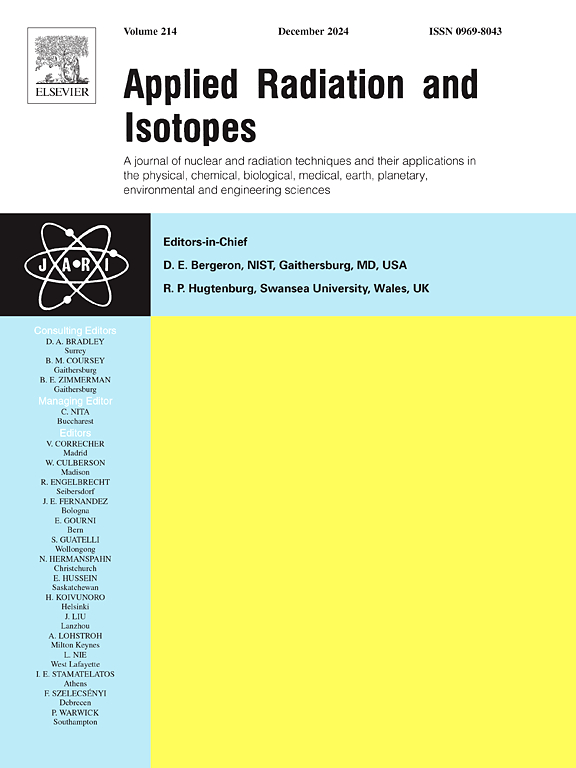Study of LiCoO2+C60 hybrid cathode using neutron and ion-beam profiling methods
IF 1.8
3区 工程技术
Q3 CHEMISTRY, INORGANIC & NUCLEAR
引用次数: 0
Abstract
Thin films of a hybrid cathode designed for all-solid-state Li-ion batteries (ASSLIBs), based on a combination of LiCoO2 (LCO) and C60 phases, were prepared by simultaneous ion beam sputtering of LiCoO2 and thermal evaporation of C60. The sub-micrometer-thick films were analyzed using the Neutron Depth Profiling (NDP) and Rutherford Back Scattering (RBS) methods (in the Center of Accelerator and Nuclear Anlytical Methods – NPI CANAM infrastructure) to measure the depth distribution of lithium, cobalt, and other building elements. Both NDP and RBS analytical methods used provided essential information about the profiling of elements in the hybrid layer and showed the influence of the fullerene phase and the charge collector metal on their distribution. It was confirmed that the presence of C60 leads to the higher accumulation of Li on the surface and their slight but broad decrease below the surface. Uneven distribution was also observed for Co, C and O. After depositing the top current collector, a significant decrease in Li and changes in concentrations of other elements occurred in the surface region. It is assumed that the uneven distributions of structural elements in the hybrid LCO + C60 mixtures are due to the difference in electrochemical potentials of the deposited elements.
LiCoO2+C60杂化阴极的中子和离子束谱分析
采用离子束溅射和C60热蒸发法制备了LiCoO2 (LCO)和C60相复合的全固态锂离子电池(ASSLIBs)复合阴极薄膜。利用中子深度剖面(NDP)和卢瑟福反向散射(RBS)方法(在加速器和核分析方法中心- NPI CANAM基础设施中)对亚微米厚的薄膜进行分析,以测量锂,钴和其他建筑元素的深度分布。使用的NDP和RBS分析方法都提供了有关杂化层中元素分布的基本信息,并显示了富勒烯相和电荷收集器金属对其分布的影响。结果表明,C60的存在导致表面上的锂积累量增加,而表面以下的锂积累量略有减少。Co、C和o的分布也不均匀。在顶部集流器沉积后,表面Li的浓度显著下降,其他元素的浓度也发生了变化。分析认为,LCO + C60混合物中结构元素的不均匀分布是由于沉积元素的电化学电位不同造成的。
本文章由计算机程序翻译,如有差异,请以英文原文为准。
求助全文
约1分钟内获得全文
求助全文
来源期刊

Applied Radiation and Isotopes
工程技术-核科学技术
CiteScore
3.00
自引率
12.50%
发文量
406
审稿时长
13.5 months
期刊介绍:
Applied Radiation and Isotopes provides a high quality medium for the publication of substantial, original and scientific and technological papers on the development and peaceful application of nuclear, radiation and radionuclide techniques in chemistry, physics, biochemistry, biology, medicine, security, engineering and in the earth, planetary and environmental sciences, all including dosimetry. Nuclear techniques are defined in the broadest sense and both experimental and theoretical papers are welcome. They include the development and use of α- and β-particles, X-rays and γ-rays, neutrons and other nuclear particles and radiations from all sources, including radionuclides, synchrotron sources, cyclotrons and reactors and from the natural environment.
The journal aims to publish papers with significance to an international audience, containing substantial novelty and scientific impact. The Editors reserve the rights to reject, with or without external review, papers that do not meet these criteria.
Papers dealing with radiation processing, i.e., where radiation is used to bring about a biological, chemical or physical change in a material, should be directed to our sister journal Radiation Physics and Chemistry.
 求助内容:
求助内容: 应助结果提醒方式:
应助结果提醒方式:


